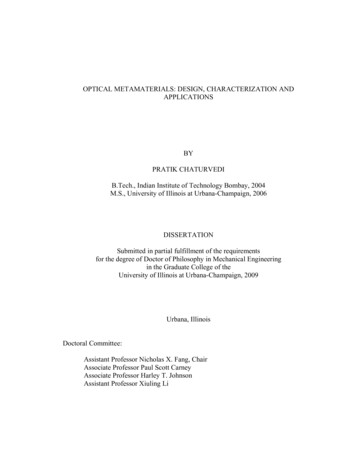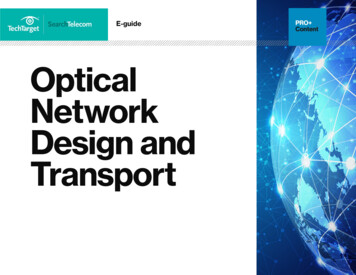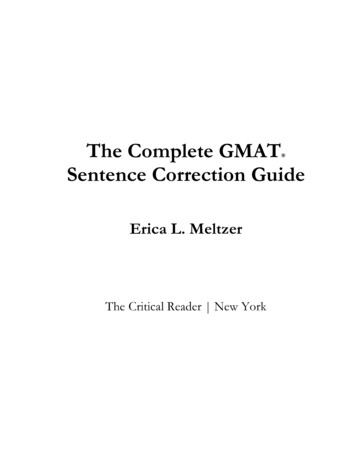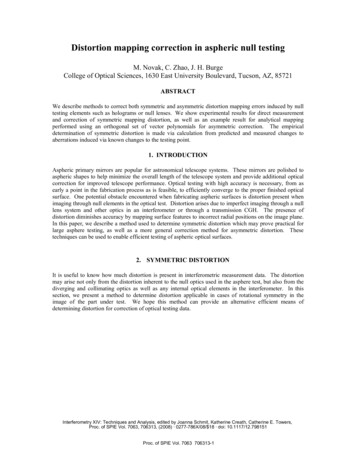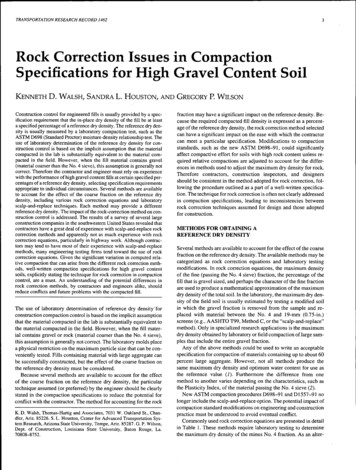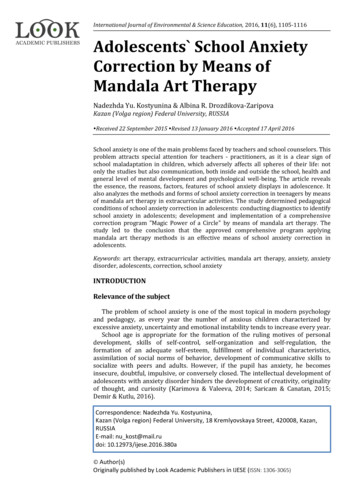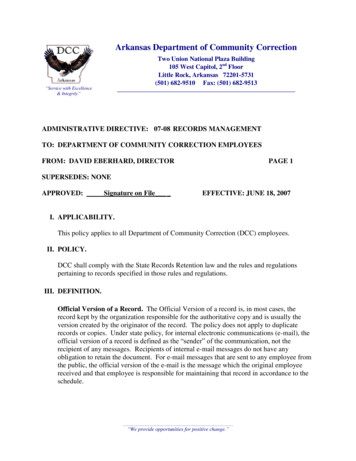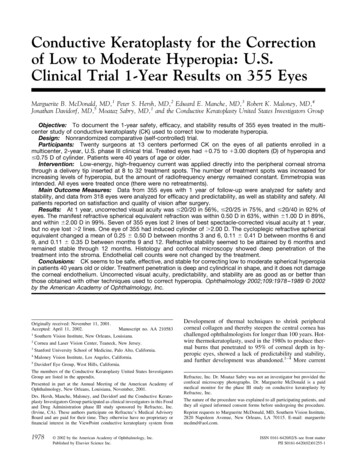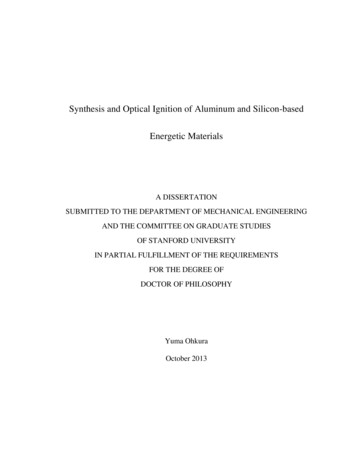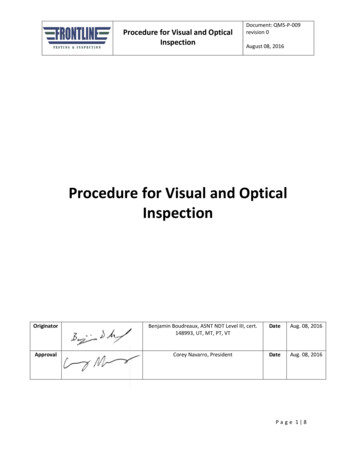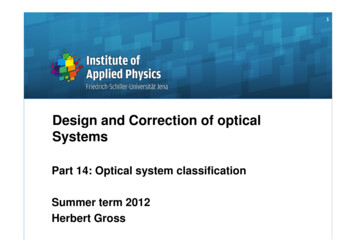
Transcription
1Design and Correction of opticalSystemsPart 14: Optical system classificationSummer term 2012Herbert Gross
Overview1. Basics2012-04-182. Materials2012-04-253. Components2012-05-024. Paraxial optics2012-05-095. Properties of optical systems2012-05-166. Photometry2012-05-237. Geometrical aberrations2012-05-308. Wave optical aberrations2012-06-069. Fourier optical image formation2012-06-1310. Performance criteria 12012-06-2011. Performance criteria 22012-06-2712. Measurement of system quality2012-07-0413. Correction of aberrations 12012-07-1114. Optical system classification2012-07-182012-04-18
Content14.1 Overview and classification14.2 Achromate14.3 Collimator14.4 Microscope optics14.5 Photographic optics14.6 Zoom lenses14.7 Telescopes14.8 Miscellaneous14.9 Lithographic projection systems
Field-Aperture-DiagramwClassification of systems withfield and aperture sizephotographicBiogon40 lithographyBraat 1987Scheme is related to size,correction goals and etendueof the systems36 32 TripletDistagon28 Aperture dominated:Disk lenses, microscopy,CollimatorField dominated:Projection lenses,camera lenses,Photographic lenses24 Sonnar20 projection16 12 doubleGausssplittripletprojectionprojectionGauss8 lithography2003diodecollimatorachromat0 00.20.4micro100x0.9micro40x0.6micro10x0.44 Spectral widthz as a correctionrequirement is missed in this limatorfocussingNA
Typical Example Systems 11. Photo objective lens2. Microscope objective lens3. Binocular4. Infrared afocal system
Typical Example Systems 25. Relay optics6. Scan-objective lens7. Collimator objective lenspossible surfacesunder test
Typical Example Systems 38. Projector lens9. TelescopeM1M210. Lithography projectionlensM3
Typical Example Systems 411. Illumination collector system12. Illumination condenser systemimagefree formedsurface13. Head mounted displaytotalinternalreflectioneyepupilfree formedsurfacefield angle 14
Typical Example Systems 5eye14. Stereo ivelensobjectplanestereoanglecommonaxis15. Zoom systemf 61f 113f 166
AchromateAchromate:- Axial colour correction by cementing twodifferent glasses- Bending: correction of spherical aberration at thefull aperture- Aplanatic coma correction possible be cleverchoice of materialsCrown infrontFour possible solutions:- Crown in front, two different bendings- Flint in front, two different bendingsTypical:- Correction for object in infinity- spherical correction at center wavelengthwith zone- diffraction limited for NA 0.1- only very small field correctedFlint infrontsolution 1solution 2
Achromate: Realization VersionsAdvantage of cementing:solid state setup is stable at sensitive middle surface with large curvatureDisadvantage:loss of one degree of freedomDifferent possible realizationforms in practice
Achromate : Basic FormulasIdea:1. Two thin lenses close together with different materials2. Total powerF F1 F23. Achromatic correction conditionIndividual power valuesF1ν1 F1 F2ν2 01ν1 2ν1 FF2 1ν1 1ν2 FProperties:1. One positive and one negative lens necessary2. Two different sequences of plus (crown) / minus (flint)3. Large ν-difference relaxes the bendings4. Achromatic correction indipendent from bending5. Bending corrects spherical aberration at the margin6. Aplanatic coma correction for special glass choices7. Further optimization of materials reduces the spherical zonal aberration
Achromate: CorrectionCemented achromate:6 degrees of freedom:3 radii, 2 indices, ratio ν1/ν2Correction of spherical aberration:diverging cemented surface with positivespherical contribution for nneg npos s'rimChoice of glass: possible goals1. aplanatic coma correction2. minimization of spherochromatism3. minimization of secondary spectrumcase with 2 solutionsRBending has no impact on chromaticalcorrection:is used to correct spherical aberrationat the edgeThree solution regions for bending1. no spherical correction2. two equivalent solutions3. one aplanatic solution, very stablecase without solution,only sperical minimum1case withone solutionand comacorrection
Achomatic solutions in the Glass Diagramflintnegative lenscrownpositive lensAchromat
AchromateAchromateLongitudinal aberrationTransverse aberrationSpot diagram486 nm y'λ 486 nmaxisrp1λ 656 nmsinu'λ 587 nm1.4 486 nm587 nm656 nm2 00.10.2 s'[mm]587 nm656 nm
AchromateResidual aberrations of an achromateClearly seen:1. Distortion2. Chromatical magnification3. Astigmatism
CollimationCollimating source radiation:Finite divergence angle is realityGeometrical part due to finite size :DθG fDiffraction part:θD λDDefocussing contribution to divergence θ 2 z sin ufdivergence θG/2sourceuDf
Collimator Optics0.1Monochromatic doubletCorrection only spherical and coma:Seidel surface contributionsLimiting : astigmatism and vature0-2Enlarged aperture : meniscus added4distortion20-2-41234sum
Collimator OpticsEnlarging numerical aperture by aplanatic-concentric meniscus lensesExtreme good correction of spherical aberrationa) NA 0.124b) NA 0.187Wrms0.2NA 0.124NA 0.187NA 0.2770.15c) NA 0.2770.1diffraction limit0.05000.10.20.30.40.5w [ ]
Microscopy - Image Planes and PupilsUpper row : image planesLower row : pupil planesKöhler setup
Upright-Microscopefilm planeSub-systems:1. Detection / Imaging pathphotocamera1.1 objective lens1.2 tube with tube lens andeyepiecebinocular beam splitter1.3 eyepieces1.4 optional equipmentfor tertube lenscollector2. Illumination2.1 lamps with collector and filterslampobjectivelensobject2.2 field aperture2.3 condenser with aperture stopcondensorcollectorlamp
Microscope Objective Lens0.5Seidel surface contributionsspherical-0.5for 100x/0.90No field flattening group00.02coma0-0.02Lateral color in tube lens um1051311158
Microscope Objective Lens: FlatteningThree different classes:1. No effort2. Semi-flatDS3. Completely ne0.2000.50.7071rel.field
Microscope Objective LensPossible setups for flatteningthe fielda)singlemeniscuslenseGoal:- reduction of Petzval sum- keeping astigmatism achromatizedmeniscus matizedtriplet solution
Microscopic Objective Lensmechanicalsetup
ClassificationSpecialQuasi-Symmetrical AngleExtrem Wide AngleTopogonFish EyeTelecentric IMetrogonTelecentric IIFamilies of photographic lensesLong historyNot noramicLensWide Angle agonCatadioptricPlasticAspheric IPlastic AsphericIIIR Camera LensUV LensBiogonTripletsVivitarRetrofocus IISingletsLess SymmetricalLandscapeErnostar capeInverse TripletSonnarPetzvalSymmetrical DoubletsPetzvalProjectionPetzval, ble GaussBiotar / PlanarPetzval,Portrait flatUltranDouble Gauss asi-Symmetrical tarAntiplanetAngulon
Photographic LensesTessarDistagonDouble GaussTele systemSuper AngulonWide angleFish-eye
Retrofocus LensesExample lens 2Distagon
Fish-Eye-LensNikon 210 Pleon(air reconnaissance)
Change of Focal LengthDistance t increasedFirst lens fixedchangeddistancetmovedlenschanged focallength f
Change of Focal LengthDistance t increasedImage plane fixedtwo lenses movedtfimageplane
Performance Variation over zSystem layoutf1f2f 50 mmt2f 67 mmf 100 mmf 133 mmf 200 mmf3f4
Performance Variation over zSeidelspherical -0.5lens 112345-0.210.223400-0.1-0.1-0.52345 -0.2 10.223400-0.1-0.1-0.52345 -0.2 10.2234000-0.1-0.10.5345 -0.2 234550.5220150.1115-50.1sum450135150.5lens 32-50.10.1-550100150.5lens 25-50.10.1lateral chromaticalaxial chromaticaldistortion0.2500-5-51234512345
Zoom Lensgroup 1Zoom lensThree moving groupsgroup 2group 3e)f' 203 mmw 5.64 F# 16.6d)f' 160 mmw 7.13 F# 13.7c)f' 120 mmw 9.46 F# 10.9b)f' 85 mmw 13.24 F# 8.5a)f' 72 mmw 15.52 F# 7.7
Basic Refractive TelescopesKepler typ:- internal focusTelescopepupila) Kepler/Fraunhofer- longer total trackintermediatefocus-Γ 0EyepieceEye pupiltelescope focal length f TGalilei typ:- no internal focusTelescopepupileyepiece focallength f Eb) Galilei- shorter total track-Γ 0Eye pupiltelescope focal length fTeyepiece focallength f E
Catadioptric TelescopesM1L1Maksutov compactL2M2L3L4, L5M1KlevtsovM2L1, L2
Astronomical TelescopePrimary andsecondary mirror
Telecentric SystemsTypical :system layout with two groupsTelecentricity error due to vignettingTelecentricity forces large diameters486 nm587 nm656 nm wtele [ ]0.9axis0.8chiefray0.70.60.53 centre ray0.40.30.25 0.10-0.100.20.40.60.81y'/y'max
Relay Systems: EndoscopesTransport over large distancesCombination of several relay subsystemsLarge field-angle objective lensApplications: Technical or medicalobjective1. relayDifferent subsystems:3. relay2. relayWrms [λλ]0.50.4486 nm587 nm656 nm0.30.20.1diffraction limit000.40.81.21.62y'[mm]
Handy Phone Objective lensesExamplesRef: T. Steinich
Beam Guiding SystemsTransport of laser light over largedistancesAdaptation of beam diameterSolutions :Telescopes of Kepler or Galilei typea)Γ 5b)Γ 5c)Γ 4d)Γ 50adjustmente)Γ 4
Beam Guiding SystemsComparison:Kepler:- internal focus- large overall lengthdark colours : Kepler / bright colours : Galilei0.020spherical-0.020.01comaGalilei:- shorter length- better correction0-0.012astigmatism 0-22curvature0-21distortion0-11234sum
Navarro Eye Model459 nmWide angle model for larger fieldsParameters for all accomodationsDescription of chromatical aberrations0 15 30 20 15 20 0 30 550 nm632 nm
Optical IllusionThe rings seemsto move
Abbe Orthoscopic EyepieceDistortion correctedGeneral problems with eyepieces:- remote eye pupil- typical eye relief 22 mmASTIGMATICFIELD 04.0004.0000.2502.0002.00018 10 0 20.000.00Distortion (%)sag20.0020 arcminLONGITUDINALSPHERICAl ABER.
Scan SystemNon-telecentrica) standard distortiony/ymax11Scan angle 2x30 c) wave aberrationb) f-θθ-distortiony/ymaxWrms 0.040.02-10%010% -0.2%00.2%0θ015 30 0 5 10 15 20 24 28 30.4
Lithographic LensesSystem with1. Illumination (horizonthal)2. Mask projection (vertical)
Lithographic Lens Example Layoutsstopreticlemaskreticle1. relay groupintermediateimagestopreticlemaskmirrorwith relaygroup2. relay groupwafer
Lithographic OpticsEUV α-Tool 2008
50Summary of Important TopicsA possible classification of optical systems is a sorting into field size and aperture sizeAperture, field size and width of wavelength range are responsable for complexityAchromate: chromatical and spherical correctionAchromate: additional degree of freedom allows for coma correction or reduction ofspherochromatismAchromate: different realization options possibleThere exist quite different types of optical systems with individual specific problems
OutlookNext lecture:Date:Special lectures and applications in the context of optical designWinter term / October 2012
case without solution, only sperical minimum case with 2 solutions case with one solution and coma correction s' rim R 1 Achromate: Correction Cemented achromate: 6 degrees of freedom: 3 radii, 2 indices, ratio ν1/ν2 Correction of spherical aberration: diverging cemented surface with positive spherical contribution for n neg n pos
